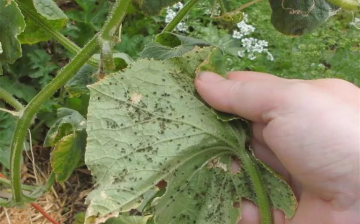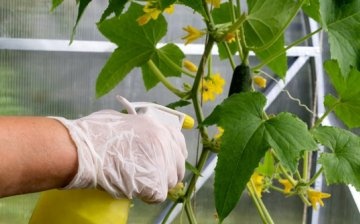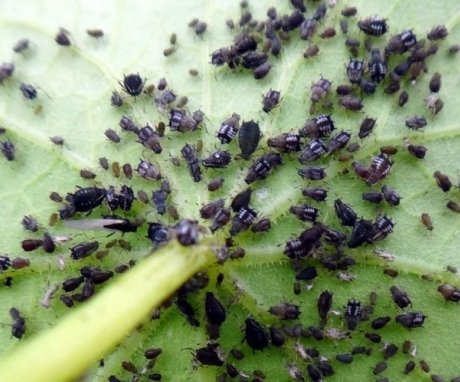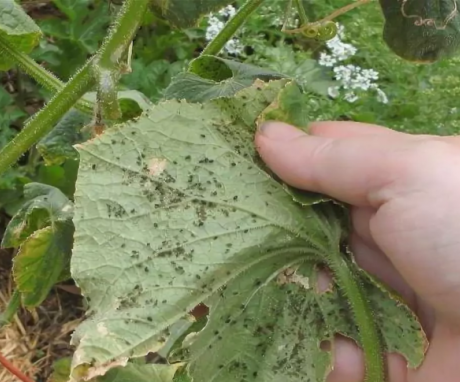Why is black aphid on cucumbers dangerous and how to effectively deal with it
In the process of growing cucumbers, the gardener often faces various problems. One of the most common problems is considered to be an invasion of vegetable crops by black aphids.
Against the background of the lesion, the leaf plates curl. The pest sucks juice from the green mass and provokes yellowing of the foliage, slowing down the growth of bushes and stopping the formation of ovaries. In order not to lose the harvest, it is important to take measures to eliminate pests as soon as possible.
What is this pest
The body of the pest resembles the shape of a hemisphere or an egg. Aphids can grow up to 0.3-0.8 mm. The integuments of the body are transparent and soft. On the surface of the body, there are tubercles and hairs of various lengths.
The mouth apparatus of the aphid is the proboscis, with the help of which the parasite is able to pierce the surface tissue of the plant and get to the sap. Aphids prefer to be located on the underside of leaf plates, stems and tops of young shoots.
Note! Aphids give off a sweet liquid that attracts ants.
Damage to cucumbers
Aphid infestation is observed in the second half of summer. At the end of July, aphids actively reproduce and are located in whole colonies on the underside of the leaf plates. The pest harms cucumber bushes and causes:
- yellowing and twisting of sheet plates;
- slowing down the growth of vegetable crops;
- loss of vigor of green spaces;
- lack of ovary;
- death of bushes;
- falling off of forming fruits.
Aphid secretes sugary juice, which promotes gluing of leaf plates. The liquid attracts various garden pests.
Signs of damage to cucumbers
Among the main signs indicating the defeat of aphid bushes, it is worth highlighting:
- the appearance of small holes on the leaf plates;
- twisting, yellowing and drying of leaf plates;
- shortening of internodes;
- slowing down the growth of bushes;
- decreased fruiting;
- deformation of the tops of the shoots.
It is very important to identify pests in a timely manner and apply methods to eliminate them.
Methods for fighting black aphids on cucumbers
There are various methods of pest control that can destroy the bushes and deprive the owner of the area of the crop. Below you can find the most effective insect control methods.
Mechanical
The mechanical method of dealing with aphids is quite effective. Experts recommend applying it early on. For this purpose, insects are washed off the leaf plates by a strong pressure of water. In addition, you can destroy pests with your hands. The process is easy enough. Before proceeding with it, it is necessary to remove insects from the leaf plates.
The mechanical method is used for 2-4 days in order to completely destroy pests and not harm green spaces.
Aphid traps are just as effective. For this purpose, a non-woven material cut into strips is used (both cotton fabric and wallpaper are perfect). The width of the strips reaches 12-15 cm. The stem of the seedlings is wrapped in a spiral with non-woven material, on top of which an adhesive tape from flies is glued.
Note! A special gel is available at gardening stores.However, it should be borne in mind that such material is quickly consumed and dries up in a sultry period.
Chemical
In cases where folk and mechanical processing methods are powerless, experts recommend using chemical methods to avoid crop loss.
The most effective chemicals that can help cope with aphids on cucumber leaves include:
- Aktaru is a systemic type insecticide that has an enteric effect and belongs to the category of neonicotinoids.
- Biotlin is an insecticide containing imidacloprid.
- Tanrek is a systemic insecticidal agent belonging to the category of neonicotinoids.
- Spark of gold is a systemic insecticidal agent that has an enteric effect.
- Spark is a drug that contains permethrin and cypermethrin.
- Cyperus is a chemical that belongs to the category of pyrethroids.
- Fufanon is a drug that belongs to the class of organophosphorus compounds and contains malathion.
The main disadvantage of using chemicals to combat aphids is the impossibility of using the fruit for 14-30 days. Chemical elements that are contained in the composition of drugs are capable of being excreted within just such a period of time. If a crop is already hanging on the bushes, ready to eat, it should be picked and thrown away.
It is advisable to use chemical methods of pest control only in cases where it was not possible to get rid of aphids in other ways.
Biological
Biological agents are considered no less effective in the fight against aphids. The most popular drugs include insecticides by type:
- Aktofit - containing aversectin C and belonging to the class of Avermectins and biological pesticides.
- Fitoverma is an enteric-type insecticide containing aversectin C.
- Sparks Bio is an enteric insecticide belonging to the class of Avermectins and biological pesticides.
- Akarina is an insecticide of the intestinal contact group.
- Bitoxibacillin is an intestinal pesticide that belongs to the category of bacterial insecticides.
Important! After using biological products, you need to wait for harvesting only 4-5 days. After a specified period of time, you can remove the fruits and eat them.
Folk ways
In cases where a large number of ovaries are observed on cucumber bushes, it is better to abandon the use of chemicals and apply folk methods to control pests. Folk methods are not only effective, but also absolutely safe.
Bitter pepper
Aphids do not tolerate bitter peppers well, so this method can help get rid of pest infestations. To prepare the product, you will need:
- Grind 3 hot pepper pods.
- Pour 9-10 liters of water into a bucket.
- Stir chopped pepper in liquid.
- The capacity is transferred to a warm room for a day.
- After a specified period of time, the tincture is filtered.
- A small amount of wood ash, 55-60 ml of liquid soap and a couple of drops of iodine must be added to the water.
- The thoroughly mixed liquid composition is poured into a spray bottle. In the evening, cucumber bushes are treated with hot pepper infusion. The liquid should fall exclusively on the sheet plates. It is unacceptable to pour the composition under the root.
To increase the effectiveness of the hot pepper infusion, it is recommended to add 45 g of tobacco dust to the composition.
Garlic
The aroma of garlic is unpleasant to pests. To prepare a highly effective infusion, you will need to peel and chop 0.6 kg of garlic and pour the raw materials into a saucepan, the volume of which reaches 3 liters. The container is filled to the brim with warm water. The infusion is aged for about 5 days, after which you can strain it and process the bushes.
Mustard
Mustard can be used to kill black aphids. The hot product (10 g) is diluted in 1000 ml of water.The tincture is aged for 3 days. After a specified period of time, 600-750 ml of boiled water and 50 ml of liquid soap are added to the liquid composition. The vegetable culture is processed with the resulting mixture using a spray bottle.
Tincture of celandine
To prepare the infusion, you will need to purchase 0.3 kg of dry herb of celandine. Experts recommend using only the root system and leaf plates of the plant. Finely chopping the raw material, put it in a bucket.
The container is filled with 10-11 liters of water. Covering the bucket with a lid, you can take it out into a warm room. After a couple of days, the tincture is filtered, after which the liquid is poured into a spray bottle for further spraying of cucumber bushes.
Note! Celandine is endowed with the peculiarity of the release of toxic substances. This is why it is important to handle the grass with gloves on. All devices that have come into contact with celandine are thoroughly washed out with dishwashing detergent.
Dandelion solution
The root system of the plants is crushed and combined with a small number of finely chopped dandelion plates. The composition is poured into a jar and filled with water. After 3 hours of infusion, the liquid is filtered and poured into a spray bottle for processing cucumber bushes.
To increase the effectiveness of the composition, it is recommended to add a small amount of tobacco dust to it.
Yarrow decoction
For cooking you will need:
- Grind 800 g fresh yarrow and pour into a deep saucepan.
- Combine the herb with 2000 ml of boiling water.
- The container is covered with a lid and left in a warm room overnight.
- After a specified period of time, the composition is poured into a bucket of water and thoroughly mixed.
- Cucumber leaf plates are abundantly sprayed with folk remedies.
Onion arrows
Having ripped off half a bucket of onion arrows, rinse them under running water and fill them with warm water. After the solution is infused for a day, it is recommended to strain it and combine it with 6 drops of iodine and 2 teaspoons of potassium permanganate. The solution for treating bushes should acquire a deep pink hue.
Horseradish with tobacco
With a massive invasion of pests, gardeners recommend using horseradish and tobacco. To prepare the infusion, you will need to combine 500 g of makhorka, 80 ml of horseradish with 12 liters of hot water. The liquid is infused for a couple of days. After a specified period of time, 90-100 ml of liquid soap is added to the solution.
The vegetable culture is sprayed with tincture using a spray bottle. A small amount of tobacco can be scattered over the beds where the cucumbers are planted.
Nuances of fighting black aphids
Below you can find information regarding the features of the fight against black aphids on cucumbers, which are planted in greenhouse conditions and in an open garden.
In the greenhouse
In order to process bushes planted in greenhouse conditions, processing should be carried out in two ways:
- chemical;
- folk.
The chemical method of processing in closed ground allows you to quickly eliminate black aphids from sheet plates. With a small number of pests, you can limit yourself to spraying the bushes with soapy water, which will not harm the crop. To prepare the solution, you will need to grind 350 g of laundry soap and dilute in 9 liters of water, waiting for complete dissolution. If desired, you can use tar soap.
In the open field
For outdoor cucumber bushes, chemical pest control is recommended. Insecticides will most effectively cope with the problem of black aphid infestations on bushes growing in an open bed.
Prophylaxis
Observing preventive measures, you can protect the vegetable crop from the invasion of pests such as black aphids.
- When planting cucumbers, it is important to adhere to the recommendations of specialists.
- During the cultivation process, it is important to take care of the vegetable crop.It is recommended to systematically apply top dressing, moisten the soil and place the bushes in well-lit areas.
- Experts advise planting garlic and onions, marigolds and calendula near cucumber bushes.
- When choosing a zone for planting seeds, it is worth giving preference to areas where melons and cucumbers have not been grown in recent years.
- The territory is checked before planting in order to detect anthills and their further destruction.
- When planting a crop in a greenhouse, the wooden elements should be preliminarily treated with lime.
Aphids that attack cucumbers are a nuisance that can be avoided. Compliance with the rules of agricultural technology and timely inspection of the bushes in order to identify pests, will avoid the invasion of black aphids, which can destroy the crop.
The best remedies for aphids on cucumbers:












I would not fight black aphids mechanically, it just doesn’t solve the issue with its larvae, sooner or later in this case, you can expect the defeat of the entire garden, and sometimes aphids can move to pumpkins and zucchini.